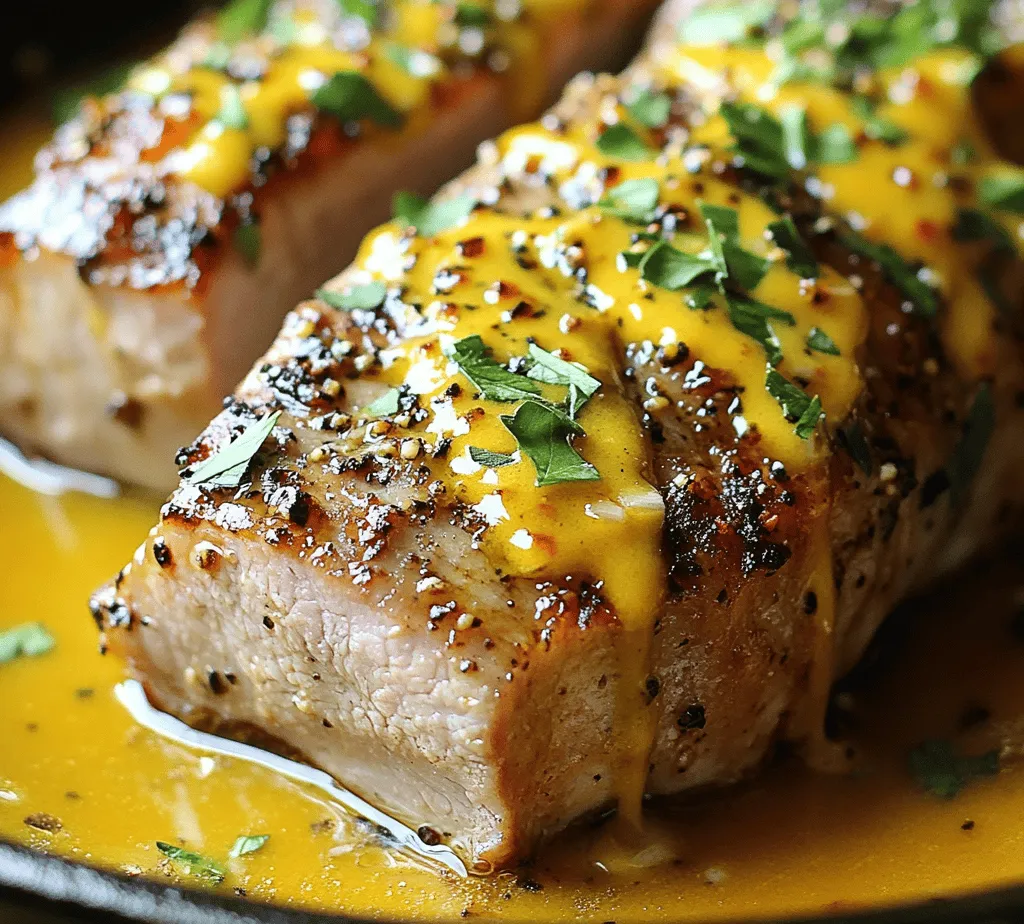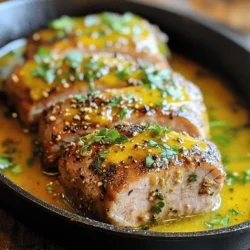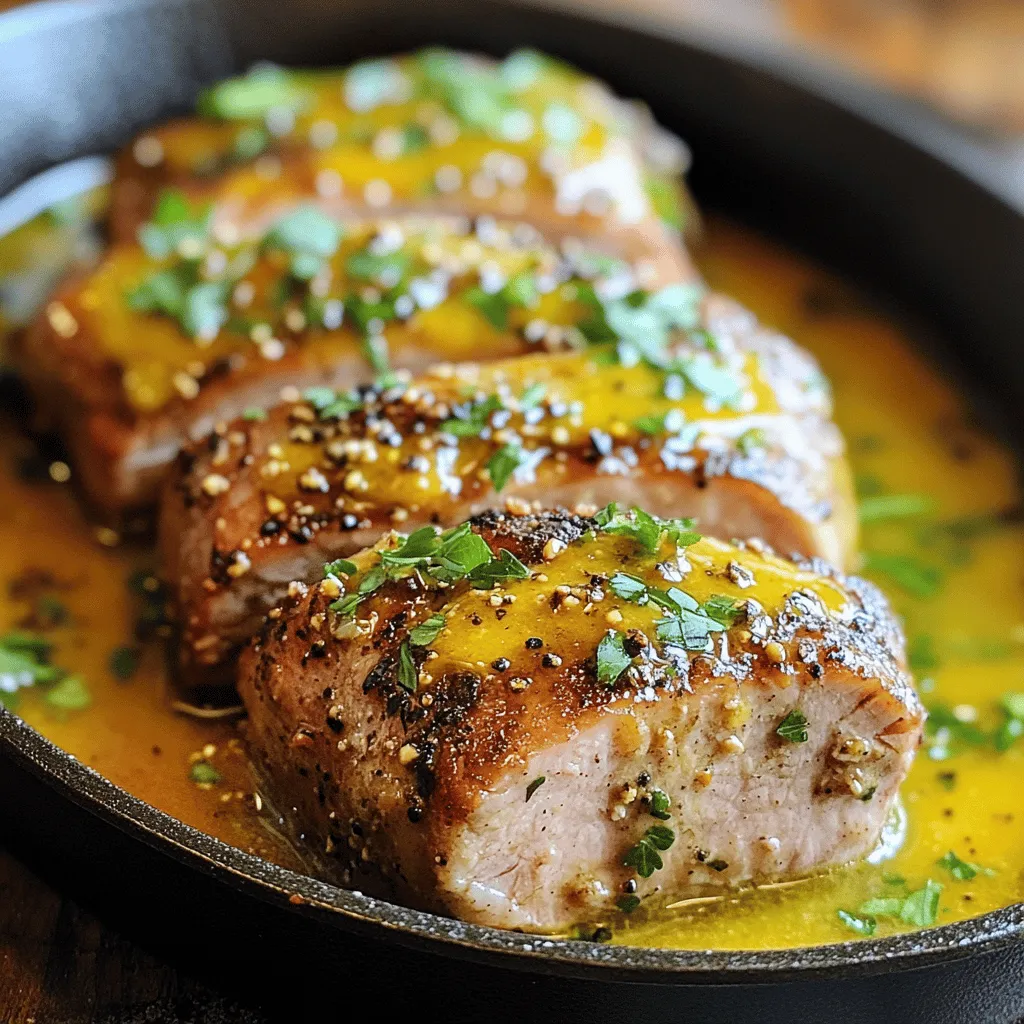Introduction
Pork tenderloin is one of the most versatile cuts of meat, prized for its tender texture and mild flavor. When prepared correctly, it can become the centerpiece of a memorable meal, appealing to both casual diners and culinary enthusiasts alike. This recipe for Pork Tenderloin with Zesty Mustard Sauce elevates this humble cut into a gourmet delight, perfect for weeknight dinners or special occasions. The combination of zesty mustard sauce not only enhances the natural flavors of the pork but also adds a tangy kick that tantalizes the taste buds.
Pork tenderloin has been a staple in various culinary traditions around the world, often celebrated for its ability to absorb flavors while remaining juicy and tender. The zesty mustard sauce is a perfect accompaniment, blending the sharpness of Dijon mustard with the sweetness of honey and the tartness of apple cider vinegar. This unique flavor profile complements the pork beautifully, creating a dish that is both satisfying and intriguing.
In addition to its culinary appeal, this dish offers a range of nutritional benefits. Pork tenderloin is an excellent source of lean protein, while the accompanying ingredients contribute vitamins and minerals essential for a balanced diet. In this article, we’ll delve into the specifics of pork tenderloin, explore the ingredients in detail, and guide you through the preparation steps to create this flavorful dish.
Understanding Pork Tenderloin
Pork tenderloin is a long, thin cut of meat that comes from the muscle that runs alongside the pig’s spine. It is often considered the most tender part of the pig, with a buttery texture that melts in your mouth. Unlike tougher cuts of pork, the tenderloin is low in fat, making it an ideal choice for health-conscious individuals.
Nutritional Benefits of Pork Tenderloin
One of the standout features of pork tenderloin is its nutritional profile. A 3-ounce serving of cooked pork tenderloin contains approximately 120 calories, 22 grams of protein, and only 3 grams of fat. It is also rich in essential nutrients like B vitamins, phosphorus, and selenium, which play vital roles in energy production and immune function. This makes pork tenderloin not only delicious but also a smart choice for a balanced diet.
Tips for Selecting High-Quality Pork Tenderloin at the Market
When shopping for pork tenderloin, look for pieces that are firm to the touch and have a pinkish-red color. The meat should be well-marbled, indicating a good balance of fat for flavor and moisture. Avoid any cuts that exhibit excessive liquid or discoloration, as these may indicate spoilage. If possible, choose organic or pasture-raised pork, which tends to be more flavorful and free from antibiotics and hormones.
Ingredients Breakdown
To create the perfect Pork Tenderloin with Zesty Mustard Sauce, each ingredient plays a critical role in flavor and texture. Let’s break down the components involved in this delicious dish.
Pork Tenderloin: Sourcing and Storage Tips
As mentioned earlier, pork tenderloin is the star of this dish. When sourcing pork, consider local butcher shops or farmers’ markets for high-quality options. Once purchased, it’s essential to store the tenderloin properly. Keep it in the refrigerator and use it within 3 to 5 days, or freeze it if you plan to use it later. For best results, thaw frozen pork in the refrigerator before cooking.
Olive Oil: Health Benefits and Alternatives
Olive oil is used in this recipe for searing the pork and adding moisture. It is rich in monounsaturated fats, which can help lower bad cholesterol levels and reduce the risk of heart disease. If you’re looking for alternatives, avocado oil or canola oil can also be used, but olive oil’s flavor profile complements the dish beautifully.
Garlic and Onion Powders: Flavor Enhancement and Substitutes
Garlic and onion powders are crucial for adding depth to the dish. They provide a concentrated flavor that enhances the overall taste of the pork. If you prefer fresh ingredients, feel free to substitute these powders with fresh minced garlic and finely chopped onions—just be sure to adjust the quantities accordingly.
Dried Thyme: Its Role in Seasoning and Health Benefits
Dried thyme is used in this recipe to impart an earthy flavor that pairs well with the pork. This herb is not only aromatic but also offers health benefits, including anti-inflammatory and antioxidant properties. If dried thyme is unavailable, fresh thyme can be used, but remember to use about three times the amount since fresh herbs are less concentrated in flavor.
Salt and Black Pepper: Importance in Cooking
Salt and black pepper are essential seasonings in any recipe. They help to enhance the natural flavors of the ingredients and bring the dish to life. Use kosher salt for seasoning, as it is easier to control than table salt. Freshly ground black pepper adds a layer of complexity to the flavor profile, so always try to use whole peppercorns for the best results.
Chicken Broth: Homemade Versus Store-Bought
Chicken broth serves as a flavorful base for the zesty mustard sauce. You can opt for homemade broth, which is rich and full of flavor, or store-bought options for convenience. If you choose store-bought, look for low-sodium varieties to control the saltiness of the sauce.
Dijon Mustard, Honey, and Apple Cider Vinegar: Creating the Zesty Sauce
The star elements of the zesty mustard sauce are Dijon mustard, honey, and apple cider vinegar. Dijon mustard is tangy and sharp, making it the perfect choice for this dish. Honey adds a touch of sweetness that balances the acidity of the vinegar. Apple cider vinegar introduces a fruity tang that brightens the sauce. Together, these ingredients create a complex flavor profile that elevates the tender pork.
Fresh Rosemary and Parsley: Garnish and Flavor Enhancement
Fresh herbs like rosemary and parsley are used as garnishes, adding both flavor and visual appeal to the dish. Rosemary offers a pine-like aroma that complements the pork, while parsley adds a fresh, bright note. These herbs not only enhance the dish’s presentation but also contribute to its overall flavor.
Preparation Steps Explained
Now that we have a solid understanding of the ingredients, let’s dive into the preparation steps to ensure your Pork Tenderloin with Zesty Mustard Sauce turns out perfectly.
Preparing the Pork: Importance of Drying and Its Effect on Searing
Before cooking, it’s vital to prepare the pork tenderloin correctly. Start by removing the tenderloin from its packaging and patting it dry with paper towels. This step is crucial because a dry surface helps achieve a perfect sear, allowing the meat to brown beautifully. If the pork is wet, it will steam instead of sear, resulting in a less appetizing texture.
Seasoning the Meat: Detailed Guide on Seasoning Techniques
Once the pork is dry, it’s time to season. Generously sprinkle kosher salt and freshly ground black pepper all over the tenderloin. For added flavor, you can also rub in the garlic and onion powders, along with the dried thyme. Be sure to massage the seasoning into the meat to ensure even coverage. This process not only enhances the taste but also builds a flavorful crust when seared.
Searing the Pork: Importance of Browning and How to Achieve It
Searing is an essential step in cooking pork tenderloin, as it locks in moisture and adds depth to the flavor. Heat a skillet over medium-high heat and add a couple of tablespoons of olive oil. Once the oil is shimmering, gently place the seasoned tenderloin in the skillet. Avoid overcrowding the pan; if necessary, sear the pork in batches. Allow the pork to cook undisturbed for about 3-4 minutes on each side until a golden-brown crust forms. This caramelization is key to developing rich flavors in your final dish.
—
In this first part of the article, we explored the important aspects of preparing a savory Pork Tenderloin with Zesty Mustard Sauce, including the appeal of the dish, the unique qualities of pork tenderloin, and the essential ingredients that contribute to its flavor. We also discussed the preparation steps needed to ensure a delicious outcome. Stay tuned for the next section, where we will continue with the cooking instructions and tips for serving this delightful dish.

Making the Zesty Mustard Sauce
Creating the zesty mustard sauce is a crucial step that elevates the flavor of your pork tenderloin. This sauce brings a delightful zing and a creamy texture that perfectly complements the savory meat. Here’s a step-by-step guide to preparing the sauce:
Ingredients for the Zesty Mustard Sauce
– 1/2 cup Dijon mustard
– 1/4 cup honey
– 1 tablespoon apple cider vinegar
– 1 tablespoon olive oil
– 1/2 cup heavy cream
– Salt and pepper to taste
– Fresh herbs (like thyme or parsley) for garnish (optional)
Instructions for Sauce Preparation
1. Combine the Mustard and Honey: In a medium-sized mixing bowl, whisk together the Dijon mustard and honey until smooth. This combination provides the sweet and tangy base for your sauce.
2. Add the Vinegar and Olive Oil: Slowly stir in the apple cider vinegar and olive oil. The vinegar adds acidity, balancing the sweetness of the honey and the sharpness of the mustard.
3. Incorporate the Cream: Gradually fold in the heavy cream, mixing until the sauce is well-blended. The cream adds a rich and velvety texture that enhances the overall mouthfeel of the dish.
4. Season the Sauce: Taste the sauce and season with salt and pepper as needed. Adjust the flavors to your liking, considering a little more honey for sweetness or additional mustard for a sharper taste.
Importance of Deglazing and Scraping the Pan
After cooking the pork tenderloin, don’t discard the drippings left in the pan. Deglazing is an essential technique that adds depth to your sauce. Here’s how to do it:
1. Heat the Pan: Place the pan used for the pork over medium heat.
2. Add Liquid: Pour a splash of white wine, broth, or even a bit of water into the pan. As it heats, use a wooden spoon to scrape up any browned bits stuck to the bottom. These bits are packed with flavor and will enhance your sauce.
3. Combine with Sauce: After deglazing, pour the liquid into your mustard sauce mixture, stirring well to incorporate all the flavors.
Balancing Flavors in the Sauce
Balancing flavors is key to a successful sauce. Consider the following tips:
– Sweetness: If the sauce is too tangy, add a bit more honey to counterbalance the acidity.
– Tanginess: If you prefer a sharper flavor, increase the mustard or vinegar.
– Creaminess: Adjust the amount of cream if you desire a thicker or lighter sauce.
Cooking Techniques
Baking and Roasting: Advantages for Pork Tenderloin
Baking and roasting are excellent cooking methods for pork tenderloin. These techniques allow for even cooking and the development of a beautiful crust that locks in moisture. Here are a couple of benefits:
– Even Heat Distribution: Both methods ensure that the pork cooks evenly, reducing the risk of overcooking and dryness.
– Flavor Development: Roasting at higher temperatures encourages the Maillard reaction, creating a deliciously browned exterior that enhances the meat’s flavor.
Understanding Cooking Temperatures and Doneness
The key to a perfectly cooked pork tenderloin is understanding the proper internal temperature. The USDA recommends cooking pork to an internal temperature of 145°F (63°C) for optimal safety and juiciness. Here’s how to check doneness:
1. Use a Meat Thermometer: Insert a digital meat thermometer into the thickest part of the tenderloin, avoiding any bones.
2. Check the Temperature: When the thermometer reads 145°F, remove the pork from the oven. Remember that the meat will continue to cook slightly while resting.
Basting: Techniques and Benefits for Flavor Infusion
Basting is a technique that involves spooning or brushing liquid over the meat while it cooks to enhance flavor and prevent dryness. Here’s how to do it effectively:
1. Prepare Basting Liquid: Use the drippings from the pan or a mixture of broth and herbs.
2. Baste Frequently: Every 15-20 minutes, open the oven and carefully spoon the liquid over the pork tenderloin. This keeps the meat moist and infuses it with additional flavors.
Serving Suggestions
Plating the Dish: Visual Appeal and Presentation Tips
Presentation plays a crucial role in the enjoyment of any dish. Here are some tips for plating your pork tenderloin with zesty mustard sauce:
1. Slice the Tenderloin: Cut the pork into medallions for an elegant presentation.
2. Drizzle the Sauce: Use a spoon to drizzle the zesty mustard sauce over the pork slices, allowing some sauce to pool on the plate for visual appeal.
3. Garnish: Add a sprinkle of fresh herbs or microgreens for color and freshness.
Suggested Side Dishes that Complement Pork Tenderloin
The right side dishes can elevate your meal. Here are some delicious options:
Roasted Vegetables
Roasted vegetables such as Brussels sprouts, carrots, and bell peppers make a colorful and nutritious side. Toss them in olive oil, salt, and pepper, and roast alongside the pork for a harmonious flavor profile.
Mashed Potatoes or Rice
Creamy mashed potatoes or fluffy rice are classic accompaniments that soak up the zesty mustard sauce beautifully. For a twist, consider herb-infused mashed potatoes or a fragrant jasmine rice.
Fresh Salads for Balance
A light salad with mixed greens, cherry tomatoes, and a tangy vinaigrette can balance the richness of the pork and sauce. Consider adding ingredients like avocado or nuts for added texture and flavor.
Flavor Pairings and Variations
Alternative Mustards and Sweeteners for the Sauce
Experimenting with different mustards and sweeteners can create new flavor experiences:
– Mustard Varieties: Try whole grain mustard for a more textured sauce or spicy brown mustard for an extra kick.
– Sweeteners: Maple syrup or agave nectar can be great substitutes for honey, offering unique sweetness and flavor profiles.
Adding Spices or Herbs for Different Flavor Profiles
Incorporate spices and herbs to personalize your sauce further:
– Herbs: Fresh rosemary or tarragon can add a delightful aromatic quality.
– Spices: A dash of cayenne pepper or smoked paprika can introduce warmth and depth.
Suggestions for Side Dishes to Enhance the Meal Experience
Consider including a cheese board with various cheeses and crackers for an appetizer. This complements the meal and offers a delightful variety for your guests.
Health Considerations
Discussing the Nutritional Profile of the Dish
Pork tenderloin is a lean cut of meat, rich in protein while relatively low in fat. A typical 3-ounce serving contains approximately:
– 22 grams of protein
– 3 grams of fat
– 0 grams of carbohydrates
Possible Dietary Modifications
To accommodate various dietary preferences:
– Gluten-Free: Ensure the ingredients, such as mustard and sauces, are gluten-free.
– Low-Carb: Pair the pork with non-starchy vegetables and limit sweeteners in the sauce for a low-carb option.
Balancing Indulgence with Healthy Eating
While the zesty mustard sauce adds richness, it’s essential to enjoy this dish as part of a balanced diet. Consider serving with plenty of vegetables to round out the meal and provide essential nutrients.
Conclusion
Pork tenderloin with zesty mustard sauce is a delightful dish that combines savory and tangy flavors in a simple yet elegant manner. The ease of preparation makes it a fantastic choice for both weeknight dinners and special occasions. The juicy, tender pork paired with the creamy, zesty sauce creates an unforgettable dining experience that will impress your family and friends.
Don’t hesitate to explore various flavor pairings and side dishes to make this recipe your own. With its rich flavors and straightforward preparation, cooking pork tenderloin with zesty mustard sauce is an enjoyable journey that encourages culinary creativity. So fire up your oven, embrace the process, and enjoy the delightful results of your cooking endeavors!


